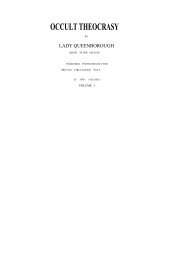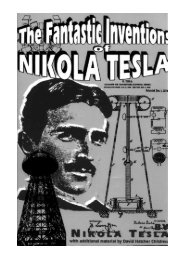the fantastic inventions of nikola tesla - Exopolitics Hong Kong
the fantastic inventions of nikola tesla - Exopolitics Hong Kong
the fantastic inventions of nikola tesla - Exopolitics Hong Kong
Create successful ePaper yourself
Turn your PDF publications into a flip-book with our unique Google optimized e-Paper software.
FIG. 3.—DISRUPTIVE DISCHARGE COIL.<br />
The coil consists <strong>of</strong> two spools <strong>of</strong> hard rubber R R, held apart at a distance <strong>of</strong> 10 centimetres by bolts c and nuts n,<br />
likewise <strong>of</strong> hard rubber. Each spool comprises a tube T <strong>of</strong> approximately 8 centimetres inside diameter, and 3<br />
millimetres thick, upon which are screwed two flanges F F 24 centimetres square, <strong>the</strong> space between <strong>the</strong> flanges<br />
being-about 3 centimetres. The secondary, S S, <strong>of</strong> <strong>the</strong> best gutta percha-covered wire, has 26 layers, 10 turns in<br />
each giving for each half a total <strong>of</strong> 260 turns. The two halve are wound oppositely and connected in series, <strong>the</strong><br />
connection between both being made over <strong>the</strong> primary. This disposition, besides being convenient, has <strong>the</strong><br />
advantage that when <strong>the</strong> coil is well balanced—that is, when both <strong>of</strong> its terminals T1 T1 are connected to bodies or<br />
devices <strong>of</strong> equal capacity—<strong>the</strong>re is not much danger <strong>of</strong> breaking through to <strong>the</strong> primary, and <strong>the</strong> insulation between<br />
<strong>the</strong> primary and <strong>the</strong> secondary need not be thick. In using <strong>the</strong> coil it is advisable to attach to both terminals devices<br />
<strong>of</strong> nearly equal capacity, as, when <strong>the</strong> capacity <strong>of</strong> <strong>the</strong> terminals is not equal, sparks will be apt to pass to <strong>the</strong><br />
primary. To avoid this, <strong>the</strong> middle point <strong>of</strong> <strong>the</strong> secondary may be connected to <strong>the</strong> primary, but this is not always<br />
practicable.<br />
The primary P P is wound in two parts, and oppositely, upon a wooden spool W, and <strong>the</strong> four ends are led out <strong>of</strong><br />
<strong>the</strong> oil through hard rubber tubes t t. The ends <strong>of</strong> <strong>the</strong> secondary T1 T1 are also led out <strong>of</strong> <strong>the</strong> oil through rubber tubes<br />
t1 t1 <strong>of</strong> great thickness. The primary and secondary layers are insulated by cotton cloth, <strong>the</strong> thickness <strong>of</strong> <strong>the</strong><br />
insulation, <strong>of</strong> course, bearing some proportion to <strong>the</strong> difference <strong>of</strong> potential between <strong>the</strong> turns <strong>of</strong> <strong>the</strong> different<br />
layers. Each half <strong>of</strong> <strong>the</strong> primary has four layers, 24 turns in each, this giving a total <strong>of</strong> 96 turns. When both <strong>the</strong> parts<br />
are connected in series, this gives a ratio <strong>of</strong> conversion <strong>of</strong> about 1:2.7, and with <strong>the</strong> primaries in multiple, 1:5.4; but<br />
in operating with very rapidly alternating currents this ratio does not convey even an approximate idea <strong>of</strong> <strong>the</strong> ratio<br />
<strong>of</strong> <strong>the</strong> E. M. Fs. in <strong>the</strong> primary and secondary circuits. The coil is held in position in <strong>the</strong> oil on wooden supports,<br />
<strong>the</strong>re being about 5 centimetres thickness <strong>of</strong> oil all round. Where <strong>the</strong> oil is not specially needed, <strong>the</strong> space is filled<br />
with pieces <strong>of</strong> wood, and for this purpose principally <strong>the</strong> wooden box B surrounding <strong>the</strong> whole is used.<br />
The construction here shown is, <strong>of</strong> course, not <strong>the</strong> best on general principles, but I believe it is a good and<br />
convenient one for <strong>the</strong> production <strong>of</strong> effects in which an excessive potential and a very small current are needed.<br />
In connection with <strong>the</strong> coil I use ei<strong>the</strong>r <strong>the</strong> ordinary form <strong>of</strong> discharger or a modified form. In <strong>the</strong> former I have<br />
introduced two changes which secure some advantages, and which are obvious. If <strong>the</strong>y are mentioned, it is only in<br />
<strong>the</strong> hope that some experimenter may find <strong>the</strong>m <strong>of</strong> use.









